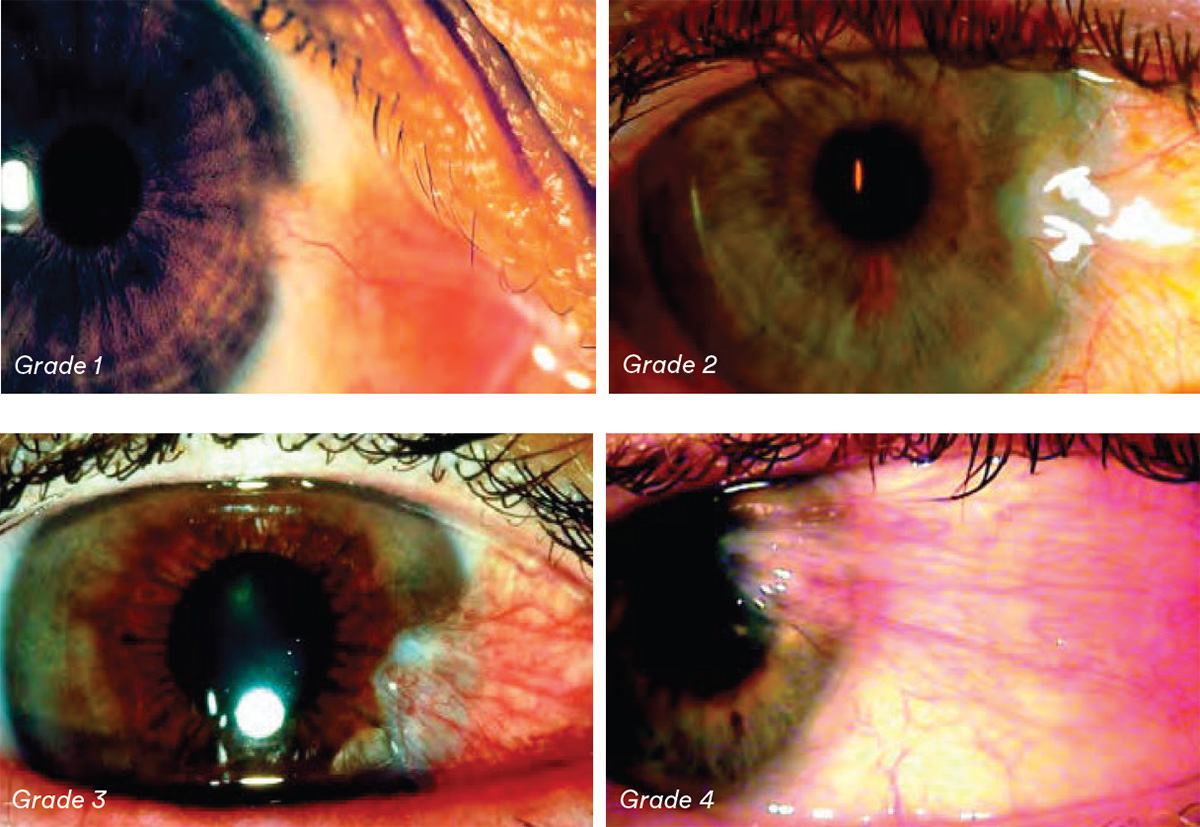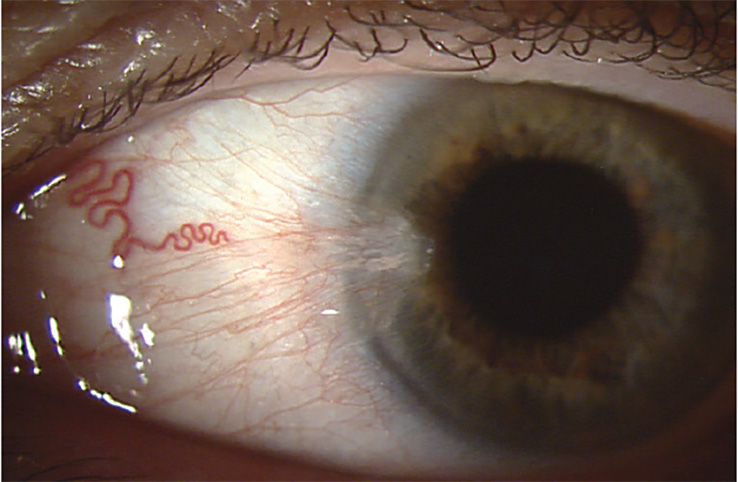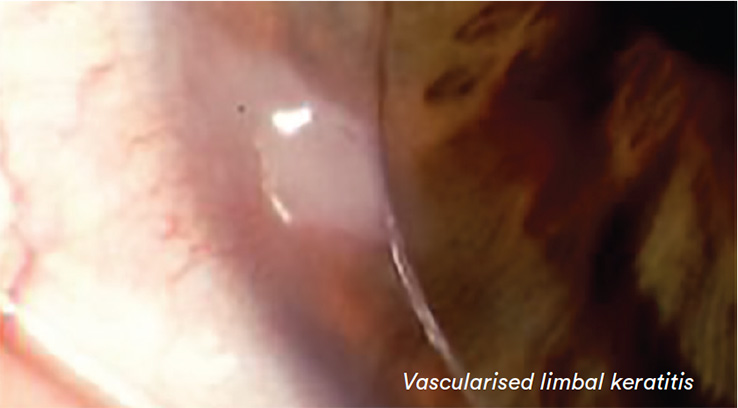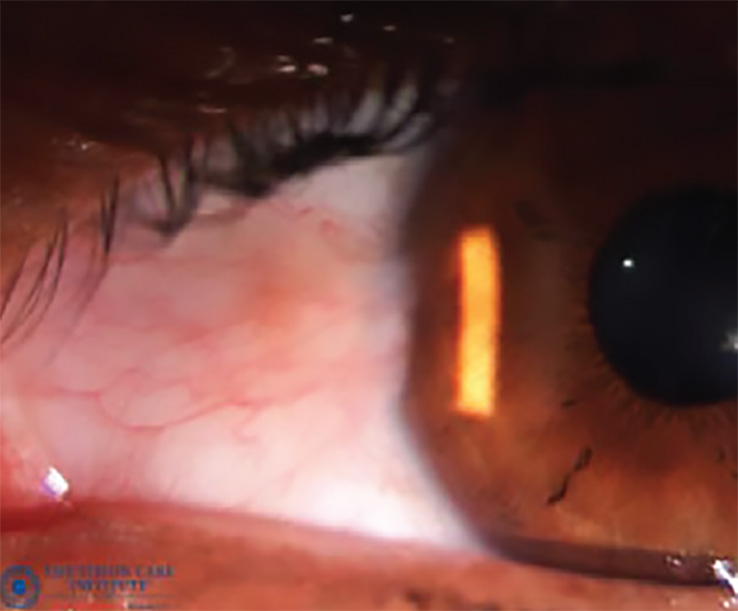What you need to know
Slit Lamp Viewing:
• Diffuse beam • Medium magnification (16x) • Direct illumination
Grading:

- Position: nasal/temporal
- Grade 0: None visible at limbus
- Grade 1: Touching limbus
- Grade 2: 1-2mm inside limbus
- Grade 3: 2-3mm inside limbus
- Grade 4: >3mm inside limbus
Incidence:
- Environment affects development - incidence varies depending on geographical location (levels of UV radiation exposure) and if closer to equator, more likely to develop pterygium
- Prevalence rates vary from < 2% in upper latitudes to 36% in lower latitudes.
- Heredity affects incidence (more common in persons of Spanish and Oriental origin)
- Not CL related but may impact CL comfort and wear time
Aetiology:
-
Degenerative collagen bundles in bulbar conjunctiva due to excessive exposure of the bulbar conjunctiva to hot, dry, windy climates and/or UV radiation
Symptoms:
- Some discomfort with or without lens wear, dryness
- Cosmetic concerns
- Vision affected if becomes large due to corneal distortion inducing astigmatism
Signs:
- Triangular growth of fibrovascular tissue on bulbar conjunctiva, usually nasal, which encroaches onto cornea and destroys Bowman’s membrane
- Often bilateral

Figure 1: Medium magnification view of nasal pterygium
What you need to recommend to your patients
Management:
- Only if discomfort occurs or if it interferes with vision — avoid mechanical trauma
- Not a contraindication for CL wear
- Occasional use of vaso-constrictors and ocular lubricants
- If severe, surgical removal may be required, followed by application of steroids, Mitomycin C or amniotic membrane
- Use of UV protection with wrap around sunglasses to prevent further deterioration
Prognosis:
- Contact lens fitting possible as long as satisfactory physical fit can be obtained
- If surgical removal required, prognosis fair although re-growth occurs in 40% cases Note: condition associated with 2 to 3x increased risk of incident late and early ARMD
Differential Diagnosis:

Vascularised limbal keratitis (VLK) — chronic inflammatory complication due to rigid lens design resulting in elevated, semi-opaque epithelial lesion at limbus with conjunctival hyperemia, corneal staining and neovascularisation.

Pinguecula - a raised yellowish nodule on bulbar conjunctiva (nasally and/or temporally adjacent to limbus). See previous moment on Pinguecula.
Further reading
- Janson BJ, Sikder S. Surgical management of pterygium. Ocul Surf 2014; 12: 112-9
- Jaros P, DeLuise V. Pingueculae and pterygia. Surv Ophthalmol 1988; 33: 41-49
- Linaburg T et al. Systematic Review: Effects of Pterygium and Pingueculum on the Ocular Surface and Efficacy of Surgical Excision. Cornea 2021; 40: 258-267
- Martins T et al. Mitomycin C in pterygium treatment. Int J Ophthalmol 2016; 9: 465-8
- Noureddin G, Yeung S: The use of dry amniotic membrane in pterygium surgery. Clin Ophthalmol 2016; 10: 705-12
- Pham T et al. Pterygium/pinguecula and the five-year incidence of age-related maculopathy. Am J Ophthalmol 2005; 139 (3): 536-5377
- Prediger J, Edmondson L. Management of CL patients with pingueculae or pterygia. Optom Vis Sci 1993; 70(1): 9-14
- Sheppard J et al.: An update on the surgical management of pterygium and the role of loteprednol etabonate ointment. Clin Ophthalmol 2014; 8: 1105-18
Click here to review our Slit Lamp Techniques Videos
Patient case study
When you have read this guide and our recommended resources, why not take part in the Johnson & Johnson Institute self-assessment quiz to test your clinical diagnostic and management skills. Choose only one answer to each question then check the answers at the foot of the page to see whether it’s correct. Good luck!
History:
Patient SP is a 45-year-old engineer who has been working in the construction industry in the Middle East for the past five years. She wears monthly replacement silicone hydrogel lenses with no UV-blocker incorporated. Although she has noticed her eyes appear red she reports no discomfort with or without her lenses.

Questions:
1. What slit lamp technique would you use to examine this patient’s bulbar conjunctiva?
A. Sclerotic scatter
B. Diffuse beam, medium illuminations
C. High magnification
D. Indirect illumination
2. What grade would you give to his Pterygium?
A. Grade 1
B. Grade 2
C. Grade 3
D. Grade 4
3. Which of the following environmental conditions are associated with this condition?
A. Air-conditioned offices
B. Shady conditions
C. High levels of UV radiation
D. Humid conditions
4. Which of the following contact lens options would you recommend for this patient?
A. Switch to UV blocking contact lenses and wraparound sunglasses
B. Refit with RGP lenses
C. Cease contact lens wear permanently
D. Orthokeratology
Answers:
1. Correct answer is B. Use a diffuse beam, medium magnification and direct illumination to examine the bulbar conjunctiva
2. Correct answer is A. Grade 1 Slit-lamp examination of the bulbar conjunctiva shows the pterygium just touching the limbus
3. Correct answer is C. High levels of UV radiation, along with living in equatorial regions, are associated with pterygium
4. Correct answer is A. Assuming a satisfactory fit can be achieved. Wraparound sunglasses and UV-blocking contact lenses, plus a wide-brimmed hat, can help protect eyes from UV transmission*

